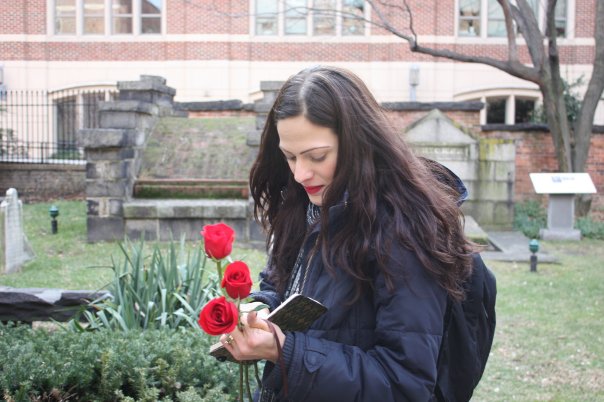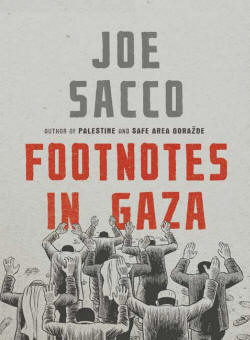I prepared as I would for any other overnight at a cemetery in the middle of January—by pulling on three layers of clothing and making sure I had all the essentials. The essentials for this stakeout were a camera, a notepad, pencil, a hot cup of tea, and Edgar Allan Poe.
With his complete works secure as an application in my iPhone, I pulled on my black knit hat and heard a tapping. I spun around to find my husband giving me the pressing nod that all husbands give to their wives as a nonverbal cue to hurry up. I looked at the time and panicked. It was 11:36 p.m., and time to go.
The hotel clerk called us a taxi, but after waiting twelve minutes we took off sprinting through the streets of downtown Baltimore. We had flown in from Chicago just for this night and wanted to make it to our destination before midnight.

As we turned down Fayette Street, it was no surprise that a crowd of about 50 people had formed outside the Westminster Hall and Burying Ground in front of both sets of tall, black gates. We caught our breaths and checked the time. We had made it. In a few minutes, this crowd of strangers, who had traveled from all over the United States, would mark Poe’s 201st birthday.
Some people greeted us with smiles or nods, others with the question on all our minds: “Do you think we’ll see him?”
“Him” being the Poe Toaster, the mysterious black-clad figure who has appeared at Poe’s grave every year for the past sixty-one years. First documented in 1949, the Poe Toaster raises a toast of cognac and leaves behind three long-stemmed red roses at the author’s grave. One rose is presumably for Poe, the second for his wife, Virginia Poe, and the third for his mother-in-law, Maria Clemm. To date, the Poe Toaster’s identity has remained secret, making him—or her—one of America’s true mysteries.
Poe himself loved a good mystery. He is credited with writing the first detective story, starring his curious investigator C. Auguste Dupin. Yet even a master detective like Dupin couldn’t unravel the circumstances surrounding the cause of Poe’s death, which remain unsolved to this day. Speculations have come and gone as to how he wound up delirious in a Baltimore gutter, only to later die. He was then buried to no fanfare in an unmarked grave in a family plot at the rear of the cemetery. Eventually he was moved to the other side of the cemetery to rest beside his wife and mother-in-law beneath a white monument engraved with his image.
A headstone engraved with a raven and an epitaph that reads “Quoth the Raven. ‘Nevermore’” marks his original burial spot. And it is here that the Toaster prefers to leave a tribute, and near which I stationed myself for the night.
With my gloved hands gripping the black bars and my face pressed close to the cold metal, I refrained from participating in any graveyard chatter. I didn’t want to risk missing the Toaster.
Poe had reached out to me with “Annabel Lee” when I was an angst-ridden preteen convinced that no one understood my sorrow. Later, “The Raven,” “The Masque of the Red Death,” and “The Murders in the Rue Morgue” would inspire me to become a mystery writer.
I came here this evening to thank him, my guide and my mentor.
At 12:20 a.m. a girl screamed, “I see someone!” She pointed out over the cemetery, her face tinged with awe and fear. I looked in the direction of her finger and saw a silhouette. The shadow of a man crept across the tombstones and vaults and then disappeared. Then suddenly, shouts erupted as we saw the flip of a man’s cape. I screamed for my husband, who had gone off to take pictures. He rushed to my side and shook my arm in congratulations. “You saw him, honey!”
I was completely thrilled. We waited for Jeff Jerome, the curator of the Poe House and Museum, to appear at the gate to ceremoniously present the three roses and bottle of cognac as proof. When he did walk out at 12:43 a.m., he only waved before returning to the church where he kept watch on the burial grounds. My heart sank. Whatever we saw, it wasn’t the Poe Toaster.
The celebrations resumed, because it was, after all, a birthday party, with a group reading of “The Raven.”
After a few hours the group dwindled to around 30 diehards. Paranoia set in as our eyes played tricks on us. At one point a gentlemen shouted, “I believe the Poe Toaster is one among us!”
He even pointed at me, perhaps because I had been mostly quiet.
There has never been any definitive evidence left by the Toaster to reveal his or her identity. All we know is that the original Poe Toaster left a note in 1993 stating that the “torch” had been passed. Later, another note indicated that the role was passed on to a son after the older Toaster died.
As the group grew impatient, we decided to sing “Happy Birthday” to Poe to help lure the Toaster out. Our chorus rang through the moss-covered graves, and the final note brought a charge of electricity. A young man cracked open the Poe book and announced he was going to read his favorite Poe poem, “A Dream Within a Dream,” written in 1849, the year of Poe’s death. The poem was fitting for such a moment; right then we all could easily have said, “All that we see or seem is but a dream within a dream.”
As it neared 5 a.m., I felt a growing pang of anxiety in the pit of my stomach. The latest that the Poe Toaster had ever left the tribute was at 5:30 a.m. in 1990. Was he—or she—running late? Was it even possible that the Poe Toaster would run late for such an important event? The idea of a no-show had never seemed possible to me.

At 5:35 a.m., Jerome and his fellow watchers approached the gate slowly, their faces solemn.
“He didn’t show,” Jerome announced.
“What happened?” I asked.
As Jerome padlocked the gates, he shrugged and smiled again, his grey mustache moving with his words. “I don’t know. The guy could have the flu.”
They left, and before long, we decided to call it a night. At Poe’s grave I decided to read my favorite poem, “The Bells,” which was published posthumously. Reading as loudly and clearly as I could, I hoped that wherever the Toaster was, he would hear and finally pay his tribute.
“Oh the bells, bells, bells! What a tale their terror tells.”
In one final show of desperation, I pressed my face to the gate and shouted, “Please Poe Toaster! I promise I will not reveal your identity if you come out now.”
There was silence.
Shakily, I said, “You have to come. It’s his birthday.”
Tears flowed down my cheeks, and I couldn’t believe that for the first time in his history the Toaster failed to arrive. I thought of Poe’s death and how he was not initially praised for his writing but was mocked as an alcoholic and buried without any salute. I did not want Poe to think we, like the Toaster, had forgotten.
Later that morning, after feeling as if I’d been stood up for the prom, I realized I needed to stop at a liquor store and a flower shop.
With three red roses in hand and a bottle of cognac, my husband and I returned to Poe’s grave, anticipating it’d be already covered by people from all over the world. But there was nothing.
I wrote a note, opened the cognac, and took a long swig before pouring some over the moist dirt. Then I set the roses and note on the tombstone. I had come here to witness the Poe Toaster, and in a Poe-like plot twist, became one.
- Follow us on Twitter: @inthefray
- Comment on stories or like us on Facebook
- Subscribe to our free email newsletter
- Send us your writing, photography, or artwork
- Republish our Creative Commons-licensed content



